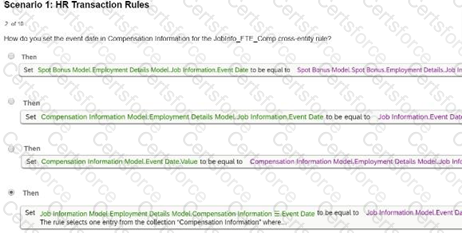How is the event reason derived when a business rule is enabled for import?
How do you set the event date in Compensation Information for the jobinfo_FTE_Comp cross-entity rule?

Which objects are supported in cross-entity business rules? Note: There are 2 correct answers to this question.
Which of the following are possible options when working with SAP SuccessFactors Employee Central employee identifiers? Note: There are 3 correct answers to this question.
What field of the country-specific Corporate Address element is required in the Corporate Data Model?
An HR admin/Global Mobility person must create a transfer for an employee. The employee will be moving from Position A in Team A to Position B in Team B. Both managers will have to approve the transfer.
How do you configure a two-step workflow so that the approval goes first to the current manager and second to the future manager?
What base object must you use for the Jobinfo_FTF_Comp rule?
In a generic object with a picklist field, what must be entered in the Valid Values Source?
What does SAP SuccessFactors recommend when you create custom associations between foundation objects (FO)?
In which business rule scenario do you use model base objects? Note: There are 2 correct answers to this question.